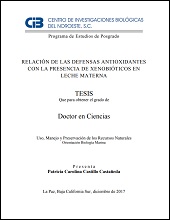| dc.contributor | TANIA ZENTENO SAVIN | |
| dc.contributor | LIA CELINA MENDEZ RODRIGUEZ | |
| dc.creator | PATRICIA CAROLINA CASTILLO CASTAÑEDA | |
| dc.date | 2017-12 | |
| dc.identifier | http://cibnor.repositorioinstitucional.mx/jspui/handle/1001/885 | |
| dc.identifier.uri | http://dspace.cibnor.mx:8080/handle/123456789/2366 | |
| dc.description | "Algunos compuestos xenobióticos procedentes del ambiente y de los alimentos son bioacumulables, y pueden ser liberados en la producción de leche materna. Durante el metabolismo, el organismo produce normalmente especies reactivas de oxígeno (ERO), algunos xenobióticos pueden aumentar esta producción y provocar daño oxidativo en lípidos, proteínas y ADN. Para contrarrestar este daño, se cuenta con un sistema antioxidante presente en leche materna, que consta de enzimas antioxidantes como superóxido dismutasa (SOD), catalasa (CAT), glutatión reductasa (GR), glutatión peroxidasa (GPx), glutatión-S-transferasa (GST) y antioxidantes no enzimáticos, como glutatión (GSH). Los procesos de metilación del ADN permiten regular la expresión de genes incluyendo GSTP1 encargado de producir la enzima GST, la cual interviene en el metabolismo de xenobióticos. El objetivo de este estudio fue evaluar la relación existente entre la concentración de xenobióticos (plaguicidas organoclorados y elementos traza) y los indicadores de estrés oxidativo presentes en leche materna, así como la influencia de la alimentación, el número de gestas y la actividad de las mujeres sudcalifornianas. El grupo de estudio incluyó 108 mujeres donantes de leche materna en su segunda semana postparto, posteriormente se realizó una toma de muestras de sangre en 34 de las 108 mujeres. Se midió la actividad de las enzimas antioxidantes, el contenido de GSH, así como la concentración de indicadores de daño oxidativo, de xenobióticos y se evaluó el estado de metilación del gen GSTP1. Se detectaron 21 plaguicidas, de los cuales el dicloro-difenil-tricloroetano, se detectó en todas las muestras de leche. La concentración de elementos traza considerados tóxicos (arsénico, mercurio, plomo y cadmio) no sobrepasó los límites permisibles establecidos por la OMS y EPA. No se encontró una relación significativa entre ERO y la concentración de xenobióticos. Se observó una baja correlación entre los indicadores de daño oxidativo a lípidos, proteínas y ADN, en relación con la concentración de plaguicidas (r < 0.40, p < 0.05), y elementos traza (r < 0.40, p < 0.05). Esto sugiere que la actividad antioxidante de SOD, GPx, GST y GR contribuye a neutralizar las ERO y a prevenir el daño oxidativo. La frecuencia de consumo de pescados y mariscos, el número de embarazos y la ocupación, no fueron factores determinantes en el nivel de contaminación de la leche materna ni en la respuesta antioxidante..." | |
| dc.description | "Some xenobiotics from the environment and food are bioaccumulative and can be released in breast milk production. During metabolism, reactive oxygen species (ROS) are produced, xenobiotics can increase this and lead oxidative damage to lipids, proteins and DNA. To counteract this damage, there is an antioxidant system present in breast milk, which consists of antioxidant enzymes such as superoxide dismutase (SOD), catalase (CAT), glutathione reductase (GR), glutathione peroxidase (GPx), glutathione S-transferase (GST) and non-enzymatic antioxidants, such as glutathione (GSH). DNA methylation allow to regulate the expression of genes including GSTP1 responsible for producing the enzyme GST, which intervenes in the metabolism of xenobiotics. The aim of this study was to evaluate the relationship between the concentration of xenobiotics (organochlorine pesticides and trace elements) and oxidative stress indicators present in breast milk, as well as the influence of diet, the number of pregnancies and the activity of women from Baja California Sur. The study group included 108 women who donated breast milk in their second postpartum week, subsequently blood samples were collected from the women donors of milk. The activity of the antioxidant enzymes, the GSH content, as well as the concentration of indicators of oxidative damage and xenobiotics were measured and the methylation status of the GSTP1 gene was evaluated. Twenty-one pesticides were detected, of which dichloro-diphenyl-trichloroethane in all milk samples was detected. Toxic trace elements (arsenic, mercury, lead and cadmium) did not exceed the permissible limits established by WHO and EPA. No significant relationship between ROS and xenobiotics was found. A low correlation between the indicators of oxidative damage to lipids, proteins and DNA in relation to the concentration of pesticides (r < 0.40, p < 0.05), and trace elements (r < 0.40, p < 0.05) was observed. It is inferred that the antioxidant activity of SOD, GPx, GST and GR helps neutralize ROS and prevent oxidative damage. The frequency of intake of fish and shellfish, the number of pregnancies and occupation, were not determining factors in the level of contamination of breast milk or in the antioxidant response..." | |
| dc.format | application/pdf | |
| dc.language | spa | |
| dc.publisher | Centro de Investigaciones Biológicas del Noroeste, S.C. | |
| dc.rights | info:eu-repo/semantics/openAccess | |
| dc.rights | http://creativecommons.org/licenses/by-nc-nd/4.0 | |
| dc.subject | info:eu-repo/classification/AUTOR/leche materna, antioxidantes, plaguicidas, elementos traza | |
| dc.subject | info:eu-repo/classification/AUTOR/breast milk, antioxidants, pesticides, trace elements | |
| dc.subject | info:eu-repo/classification/cti/2 | |
| dc.subject | info:eu-repo/classification/cti/23 | |
| dc.subject | info:eu-repo/classification/cti/2306 | |
| dc.subject | info:eu-repo/classification/cti/230218 | |
| dc.subject | info:eu-repo/classification/cti/230218 | |
| dc.title | Relación de las defensas antioxidantes con la presencia de xenobióticos en leche materna | |
| dc.type | info:eu-repo/semantics/doctoralThesis | |
| dc.type | info:eu-repo/semantics/acceptedVersion | |


